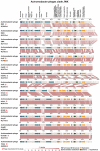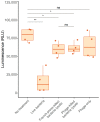Compounding Achromobacter Phages for Therapeutic Applications
- PMID: 37632008
- PMCID: PMC10457797
- DOI: 10.3390/v15081665
Compounding Achromobacter Phages for Therapeutic Applications
Abstract
Achromobacter species colonization of Cystic Fibrosis respiratory airways is an increasing concern. Two adult patients with Cystic Fibrosis colonized by Achromobacter xylosoxidans CF418 or Achromobacter ruhlandii CF116 experienced fatal exacerbations. Achromobacter spp. are naturally resistant to several antibiotics. Therefore, phages could be valuable as therapeutics for the control of Achromobacter. In this study, thirteen lytic phages were isolated and characterized at the morphological and genomic levels for potential future use in phage therapy. They are presented here as the Achromobacter Kumeyaay phage collection. Six distinct Achromobacter phage genome clusters were identified based on a comprehensive phylogenetic analysis of the Kumeyaay collection as well as the publicly available Achromobacter phages. The infectivity of all phages in the Kumeyaay collection was tested in 23 Achromobacter clinical isolates; 78% of these isolates were lysed by at least one phage. A cryptic prophage was induced in Achromobacter xylosoxidans CF418 when infected with some of the lytic phages. This prophage genome was characterized and is presented as Achromobacter phage CF418-P1. Prophage induction during lytic phage preparation for therapy interventions require further exploration. Large-scale production of phages and removal of endotoxins using an octanol-based procedure resulted in a phage concentrate of 1 × 109 plaque-forming units per milliliter with an endotoxin concentration of 65 endotoxin units per milliliter, which is below the Food and Drugs Administration recommended maximum threshold for human administration. This study provides a comprehensive framework for the isolation, bioinformatic characterization, and safe production of phages to kill Achromobacter spp. in order to potentially manage Cystic Fibrosis (CF) pulmonary infections.
Keywords: Achromobacter phage; phage production; phage therapy; prophage induction.
Conflict of interest statement
The authors declare no conflict of interest.
Figures







References
-
- Jakobsen T.H., Hansen M.A., Jensen P.Ø., Hansen L., Riber L., Kolpen M., Hansen C.R., Rønne Hansen C., Ridderberg W., Eickhardt S., et al. Complete Genome Sequence of the Cystic Fibrosis Pathogen Achromobacter xylosoxidans NH44784-1996 Complies with Important Pathogenic Phenotypes. PLoS ONE. 2013;8:e68484. doi: 10.1371/journal.pone.0068484. - DOI - PMC - PubMed
-
- Manckoundia P., Mazen E., Coste A.S., Somana S., Marilier S., Duez J.M., Camus A., Popitean L., Bador J., Pfitzenmeyer P. A Case of Meningitis Due to Achromobacter xylosoxidans Denitrificans 60 Years after a Cranial Trauma. Med. Sci. Monit. 2011;17:2010–2012. doi: 10.12659/MSM.881796. - DOI - PMC - PubMed
Publication types
MeSH terms
Substances
Grants and funding
LinkOut - more resources
Full Text Sources
Medical
Miscellaneous

